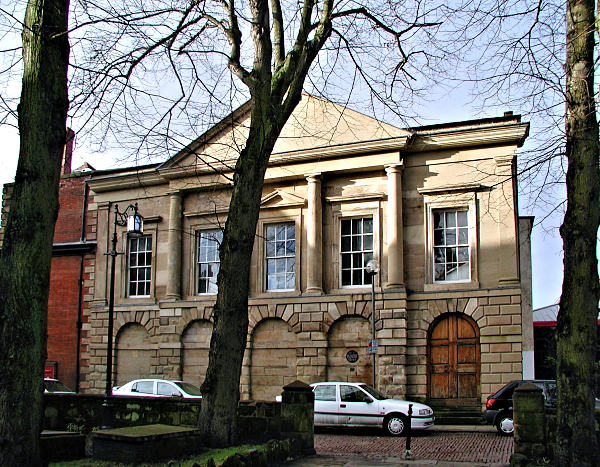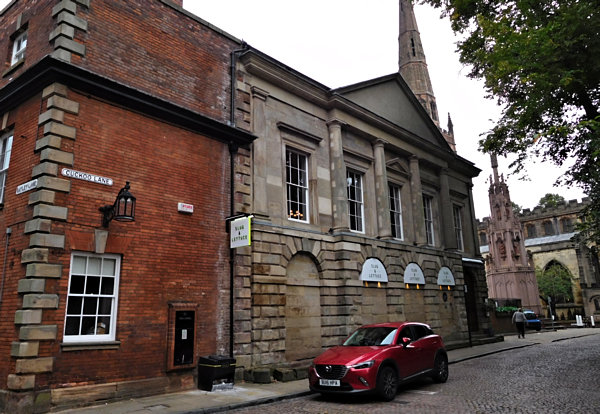Establishment, Cuckoo Lane
| These premises have been known by different names during their history: | FROM | TO | NAME |
| 2012 | 2017 | Establishment | |
| 2017 | Slug and Lettuce | ||
 The building dates back to 1783 when it housed the city's courts and was built by architect Samuel Eglinton. The land next to the building was used as a jail and the Prison Governor's House is still attached to the County Hall building on the corner of Pepper Lane. It retained the name County Hall after Coventry's status as a county in its own right was removed by the Boundary Act in 1847. It was also one of the few 18th-century public buildings in the city and is the only one to survive.
They are now refurbished to a very high standard and form the Establishment. After lying empty for decades it reopened as a bar and restaurant in May 2012.
Many of the building's original features have been kept, the judge's oak seat has been restored, the dock has been opened up for people to see into, the viewing gallery has been kept and the cells have been transformed into a dining area.
During restoration work cell padlocks and keys, transcripts and judge's notes were uncovered and they are now hanging on the walls.
The most famous case heard at the courts was that of Mary Ball in 1849, the last ever person to be hanged in Warwickshire. The 31-year-old had three months earlier bought a "pennyworth" of arsenic from a local chemist in Market Place explaining that she wanted it to "kill bugs." Instead, she'd put the poison on a mantleshelf at her home in Back Lane, Nuneaton. When husband Thomas returned from a fishing trip complaining of feeling ill, Mary casually suggested he took the "salts" on the shelf as they would do him good. Thomas, aged 28, who had a reputation as a drinker and womaniser, died in agony.
After six hours of evidence and summing up, the jury found Mary guilty but accompanied their verdict with a plea for mercy. When Judge Coleridge demanded to know on what grounds, they said they had some problems with some of the evidence. This was a covert proposal for a bargain with the judge, a guilty verdict in return for some assurance Mary would be spared the statutory death penalty. But the judge was adamant and instructed the jurymen to reconsider their verdict.
They did so without leaving the court and found Mary guilty of willful murder.
Justice Coleridge donned his black cap and sentenced Mary Ball to death by hanging.
The building dates back to 1783 when it housed the city's courts and was built by architect Samuel Eglinton. The land next to the building was used as a jail and the Prison Governor's House is still attached to the County Hall building on the corner of Pepper Lane. It retained the name County Hall after Coventry's status as a county in its own right was removed by the Boundary Act in 1847. It was also one of the few 18th-century public buildings in the city and is the only one to survive.
They are now refurbished to a very high standard and form the Establishment. After lying empty for decades it reopened as a bar and restaurant in May 2012.
Many of the building's original features have been kept, the judge's oak seat has been restored, the dock has been opened up for people to see into, the viewing gallery has been kept and the cells have been transformed into a dining area.
During restoration work cell padlocks and keys, transcripts and judge's notes were uncovered and they are now hanging on the walls.
The most famous case heard at the courts was that of Mary Ball in 1849, the last ever person to be hanged in Warwickshire. The 31-year-old had three months earlier bought a "pennyworth" of arsenic from a local chemist in Market Place explaining that she wanted it to "kill bugs." Instead, she'd put the poison on a mantleshelf at her home in Back Lane, Nuneaton. When husband Thomas returned from a fishing trip complaining of feeling ill, Mary casually suggested he took the "salts" on the shelf as they would do him good. Thomas, aged 28, who had a reputation as a drinker and womaniser, died in agony.
After six hours of evidence and summing up, the jury found Mary guilty but accompanied their verdict with a plea for mercy. When Judge Coleridge demanded to know on what grounds, they said they had some problems with some of the evidence. This was a covert proposal for a bargain with the judge, a guilty verdict in return for some assurance Mary would be spared the statutory death penalty. But the judge was adamant and instructed the jurymen to reconsider their verdict.
They did so without leaving the court and found Mary guilty of willful murder.
Justice Coleridge donned his black cap and sentenced Mary Ball to death by hanging.
 All the roads into Coventry were packed with an estimated 20,000 people. Crowds from Nuneaton, Bedworth and Foleshill walked or rode into the city centre to witness the hanging of the Nuneaton inn-keeper's daughter. The execution took place on a scaffold mounted on the exterior of the prison wall adjoining the County Hall in Cuckoo Lane. As stipulated at the trial, her body was buried in unconsecrated grounds inside the prison yard.
The gaol of the County Hall Courthouse was built on the site of the GOLDEN HORSE, Bayley Lane.
All the roads into Coventry were packed with an estimated 20,000 people. Crowds from Nuneaton, Bedworth and Foleshill walked or rode into the city centre to witness the hanging of the Nuneaton inn-keeper's daughter. The execution took place on a scaffold mounted on the exterior of the prison wall adjoining the County Hall in Cuckoo Lane. As stipulated at the trial, her body was buried in unconsecrated grounds inside the prison yard.
The gaol of the County Hall Courthouse was built on the site of the GOLDEN HORSE, Bayley Lane. | |||
LICENSEES:2012 Simon Close | |||
| Previous page: Engine Inn | This page: Establishment | Next page: Ewe and Lamb |